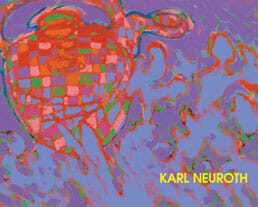Preface to the catalog for the exhibit Karl Neuroth. Held at the Linder Gallery, Keystone College, October 9 to December 4, 2005.

It has been a great pleasure to put together this exhibition of Karl Neuroth’s paintings for the Linder Gallery at Keystone College, the institution Neuroth served for forty years and where he established the very highly respected program in fine arts. As an educator, division chairperson, gallery director, and in so many other roles he fulfilled over the years, Karl embodied the excellence that is Keystone College. As a painter whose work continues to evolve in new and sometimes surprising directions, he represents all that is excellent in contemporary art. This exhibition is a celebration of his many contributions to education and the arts, and inaugurates that 2005-2006 exhibition series for the Linder Gallery.
It is fitting that the exhibit coicides, coincidentally (but almost precisely), with the centennial anniversary of the famous Salon d’Automne of 1905, the Paris exhibit that began the Fauve revolution in painting. It was there that the critic Louis Vauxcelles, aghast at the intensely-colored and unmodulated paintings of Matisse, Derain, Vlaminck, and others, found refuge in a series of academic sculptures and declared, “Donatello chez les fauves!” (“Donatello among the wild beasts!”). It was, as one textbook claims, perhaps the most celebrated baptism of twentieth-century art1, a shot of pattern and color heard round the world.
If it is difficult today to imagine how anyone could describe these artists as wild beasts, it is even more inconceivable to apply this moniker to Karl Neuroth. But in Fauvism, and especially in the art of Matisse, we find perhaps the closest precedent for his art. “Pattern and color” are the words Neuroth invariably uses in discussing his work, and those same terms just as accurately apply to descriptions of Matisse and the Fauves.
But the comparison goes beyond a similarity of style. Erika Funke, in her essay that follows, writes eloquently of Neuroth’s art with respect to his German heritage, and specifically to the influence of his grandfather, Johann Otto Neuroth. She describes the meticulous skill involved in Johann’s work as a painter of decorative motifs, and the impact his pattern making had on the young Karl. In terms of content, however, specifically their positive and life-affirming qualities, Karl Neuroth’s paintings suggest less of a German worldview and more of a French–or more accurately, more of a Mediterranean—outlook on life. It was, of course, on the Cote d’Azur, at Saint-Tropez, Collioure and Nice, where Matisse realized so many of his great works. It is not surprising, therefore, that we learn Neuroth’s great breakthrough came during a visit to nearby Spain in the mid-1990s, and resulted in his series of tapas paintings. Throughout his work, we find none of the anxiety, none of the Sturm und Drang of so much German painting, but rather the joie de vivre of the Mediterranean.
“Grounded” imagery is the term Erika Funke uses, and she describes the “sense of rightness” Karl’s paintings evoke. Certainly Matisse was on the same track when he famously wrote of his own work, “What I dream of is an art of balance, of purity and serenity devoid of troubling subject matter, an art that might be for every mental worker…like an appeasing influence, like a mental soother, something like a good armchair in which to rest from physical fatigue.”2
As with all exhibitions, this one could not have been realized without the contributions of many individuals. Thanks, first, to Karl Neuroth, for agreeing to the exhibition, but thanks most of all because without Karl’s vision, effort, and enthusiasm the fine arts program at Keystone College and the exhibition series simply would not be. Thanks also to Laura Craig of the Laura Craig Galleries, Scranton, for helping curate the exhibit, and to Rolfe Ross for the back cover photograph of Karl in his studio. Finally, a special thanks to Erika Funke of WVIA FM Public Radio in northeast Pennsylvania, for writing the wonderful essay on Karl’s life and work.
Notes
- Hal Foster et al., Art Since 1900 (Thames and Hudson, 2004).
- Henri Matisse, Notes of a Painter (1908).
